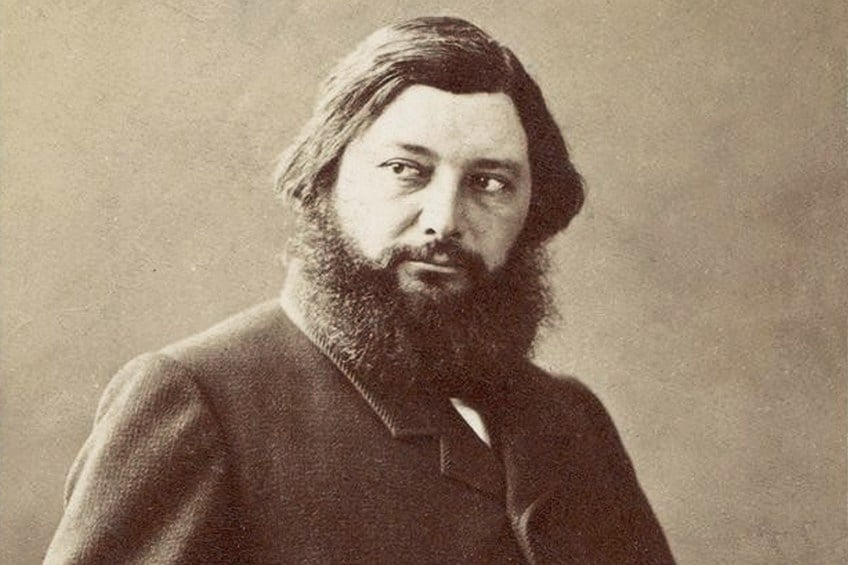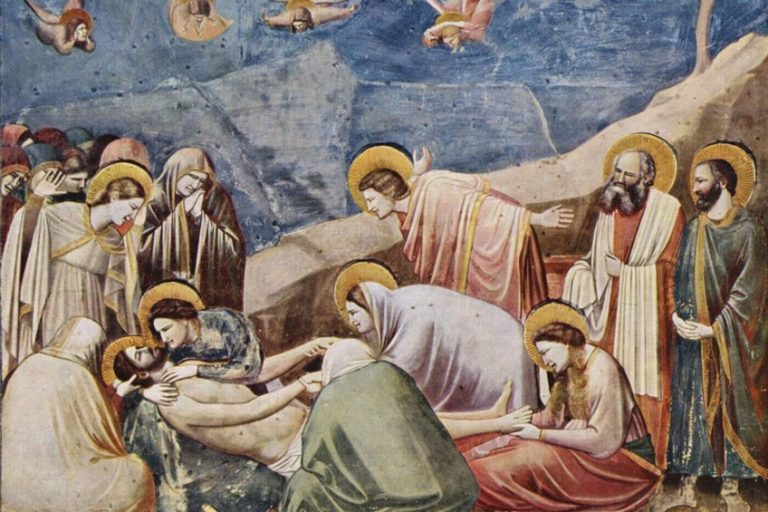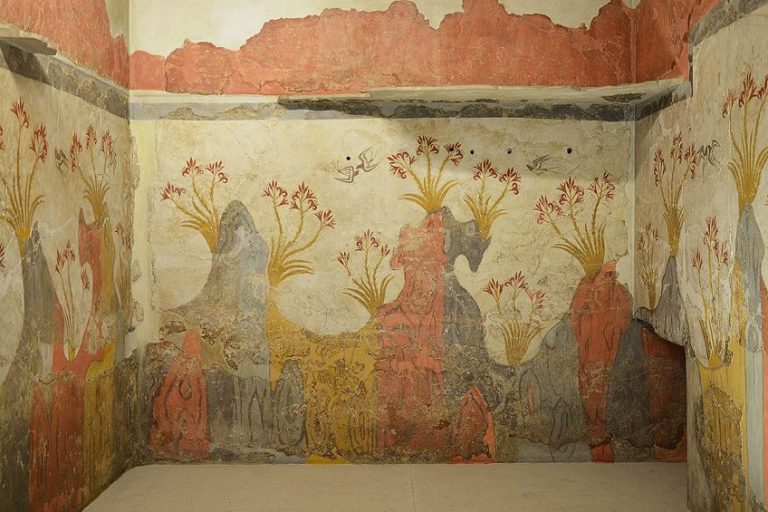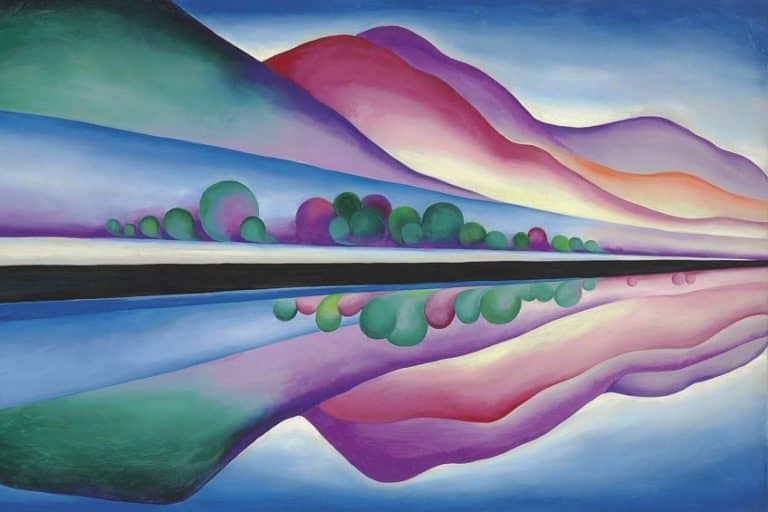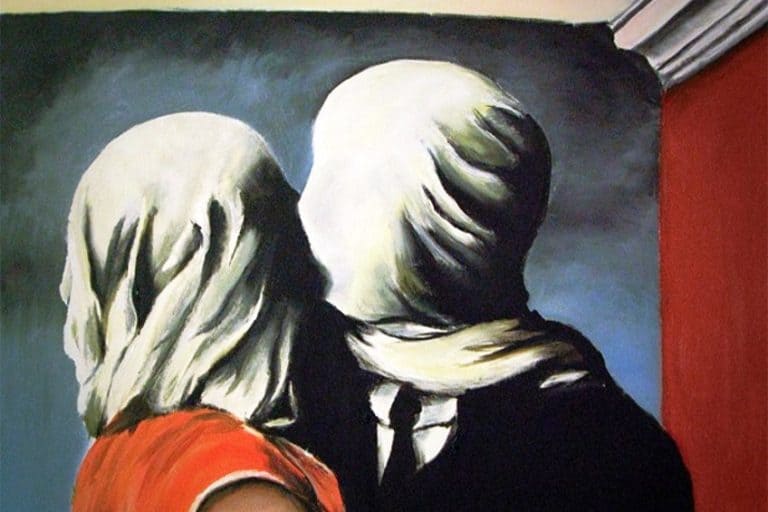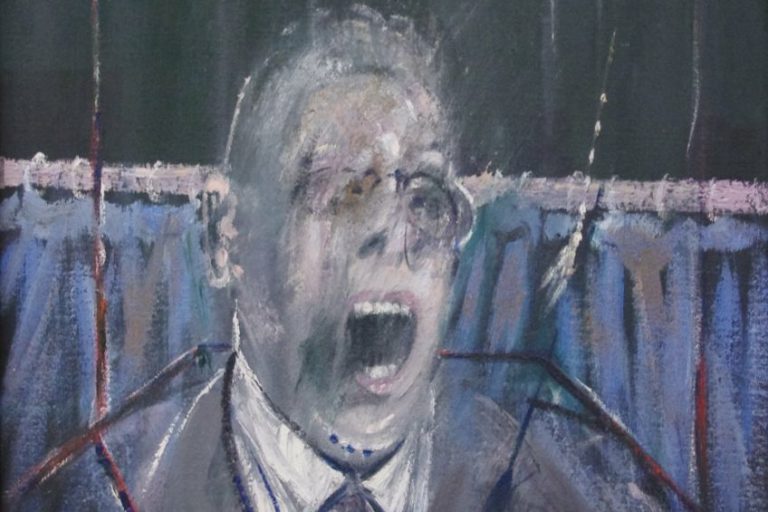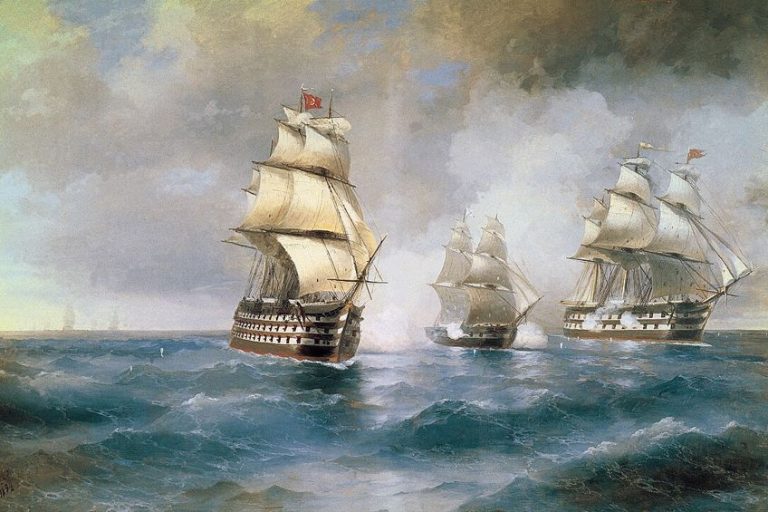“The Origin of the World” by Gustave Courbet – Art by Gustave Courbet
The Origin of the World (1866) by Gustave Courbet is probably not what you think it is. The title is neither a geographical region nor a mythological tale, but the nether regions of a female nude. This is the painting we will discuss in more detail below. For younger readers, we advise adult content.
Table of Contents
Who Was Gustave Courbet?
Jean Désiré Gustave Courbet was and is an important figure in the world of art, considered a forefather of the Realism art style. He was born in France in Ornans on June 10, 1819, and died on December 31, 1877, in Switzerland from liver disease. During his early 20s, he lived in Paris, which exposed him to the artworks from great artists of years prior, whom he studied on his own; he reportedly did not join any of the academic art institutions.
He was revolutionary in his approach to art and his subject matter, painting only what he could see, and he influenced many other popular artists from art movements like Impressionism and Post-Impressionism.
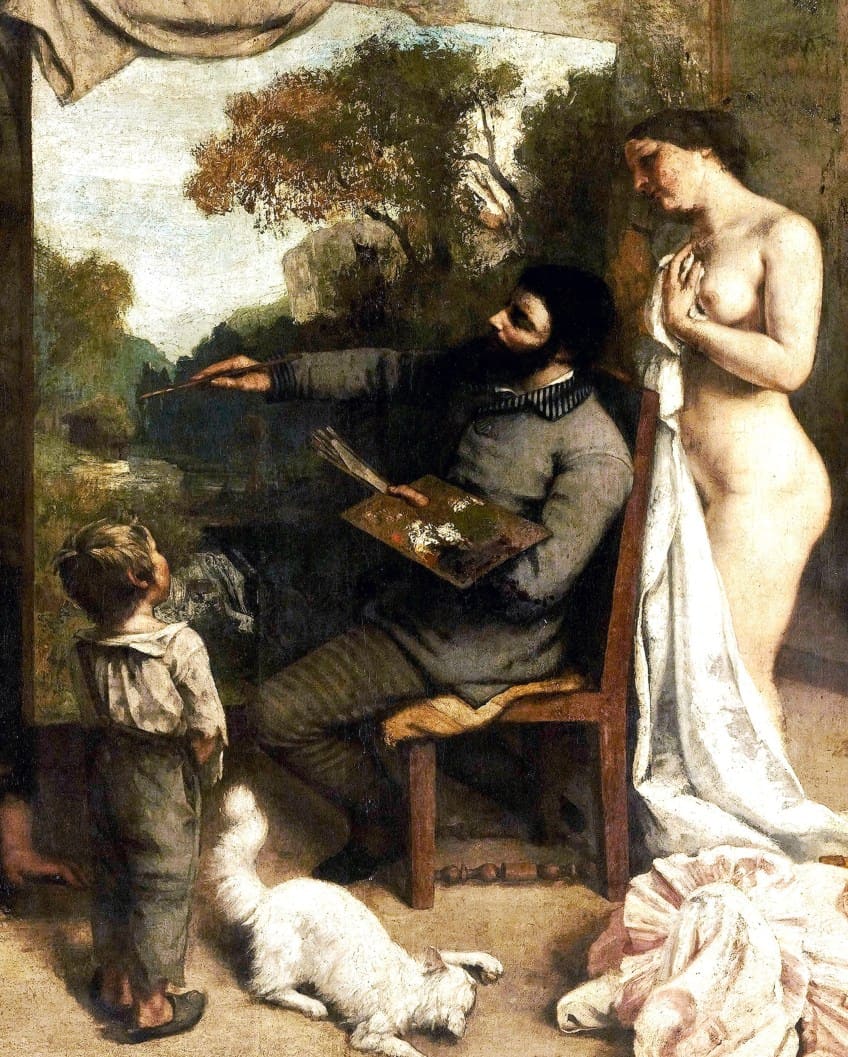
The Origin of the World (1866) by Gustave Courbet in Context
The Origin of the World by Gustave Courbet, or L’Origine du Monde in French, is a nude painting that has opened many avenues through which to debate its stark exploration of nudity and the many questions that inevitably arise.
Below, we will discuss the contextual background of this painting, discussing Courbet’s approach to Realism a bit more, and the painting’s origin. We will also provide a formal analysis, which will look at some of the artistic techniques the artist utilized.
| Artist | Gustave Courbet |
| Date Painted | 1866 |
| Medium | Oil on canvas |
| Genre | Nude painting |
| Period / Movement | Realism |
| Dimensions | 46.3 (H) x 55.4 (L) centimeters |
| Series / Versions | N/A |
| Where Is It Housed? | Musée d’Orsay, Paris, France |
| What It Is Worth | Sold for over $4,000 in 1955. |
Contextual Analysis: A Brief Socio-Historical Overview
To have a better understanding of Gustave Courbet as an artist, and to set the stage for his L’Origine du Monde painting, it is useful to know a bit more about Realism, which was an art movement attributed to Courbet himself.
Mostly active during the middle of the 1800s in France and predominantly in Paris, Realism, in simple terms, was about depicting life as it was. Artists did not portray what is often described as idealistic, scenes and subjects from art governed by the Academic style and the preceding art movements like Romanticism and Neoclassicism.
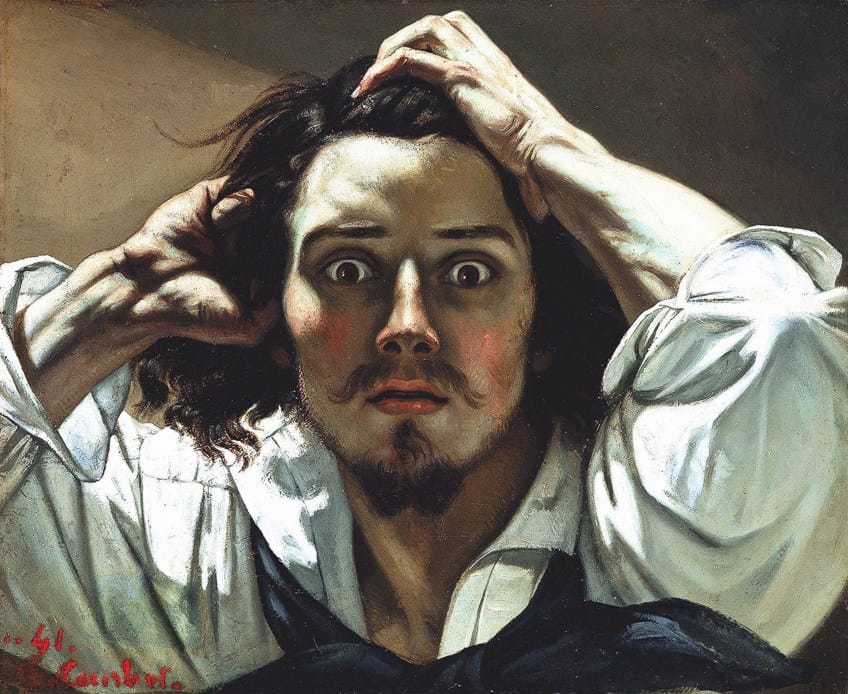
The Academic painting style was all about depicting scenes based on historical or mythological events that did not really have much to do with “contemporary” life, and contemporary life in Paris was wholly different. This was a time of urban, social, and technological development, as well as the French Revolution of 1848.
Realism is also often described by many art sources as the “first” modern art style. There was more authenticity around the portrayed subject matter, which undoubtedly gave people something they could relate to, especially the working-class citizens.
Another important point about Realism was that artists did not focus on heightened emotional states that would be seen in Romantic paintings. Sometimes, the term “sentimental” is also utilized to describe the Romantic approach, which was a trait Realists did not ascribe to.
Courbet’s Realism and Shock
Gustave Courbet painted a variety of people, from peasants to prostitutes, and the wealthy to the working class, including a variety of settings, from working with wheat, wrestling, and more. A painting that elicited significant critique was his Burial at Ornans (c. 1849), which depicted a funeral with regular people on a canvas over 10 feet in size, a size usually utilized for History paintings.
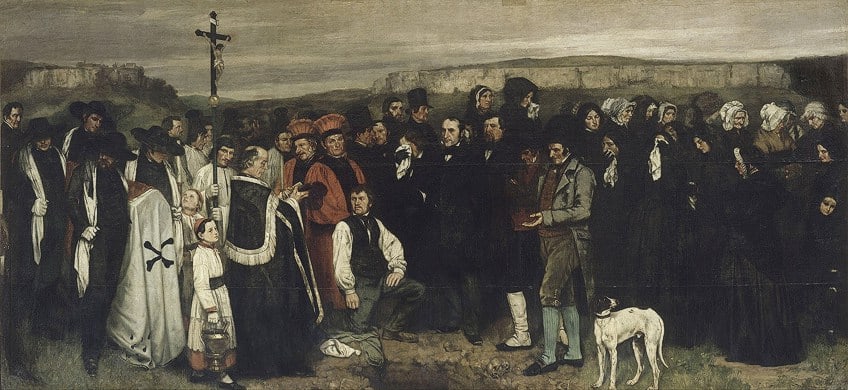
This was one of Courbet’s best examples of Realism painting, however, it was not his only. While he also painted various landscape scenes with figures like the above-mentioned, his figures also extended beyond everyday settings into the world of eroticism, otherwise referred to as “Erotic Realism”.
Courbet produced several compositions of nude figures, including The Origin of the World. Other examples include The Bathers (1853), Femme nue Couchée (1862), and Sleep (1866), all depicting female nudes.
These paintings are examples of Courbet’s exploration of the nude figure unabashedly portrayed out of the classical idealized context.
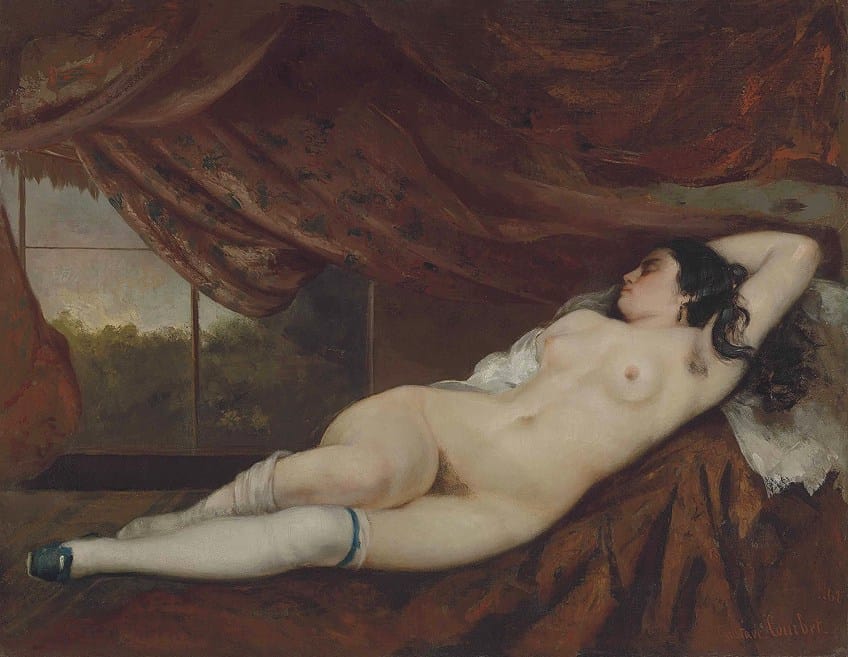
Courbet is often described as being a notorious figure in the world of art because of his revolutionary and seemingly rebellious approach to depicting everyday people in everyday scenes. Courbet’s subject matter, often depicting female nudes, caused much shock and critique across the world of art.
He did not follow traditional rules of painting and many art sources will explain that this gave him publicity, regardless of whether it was positive or negative.
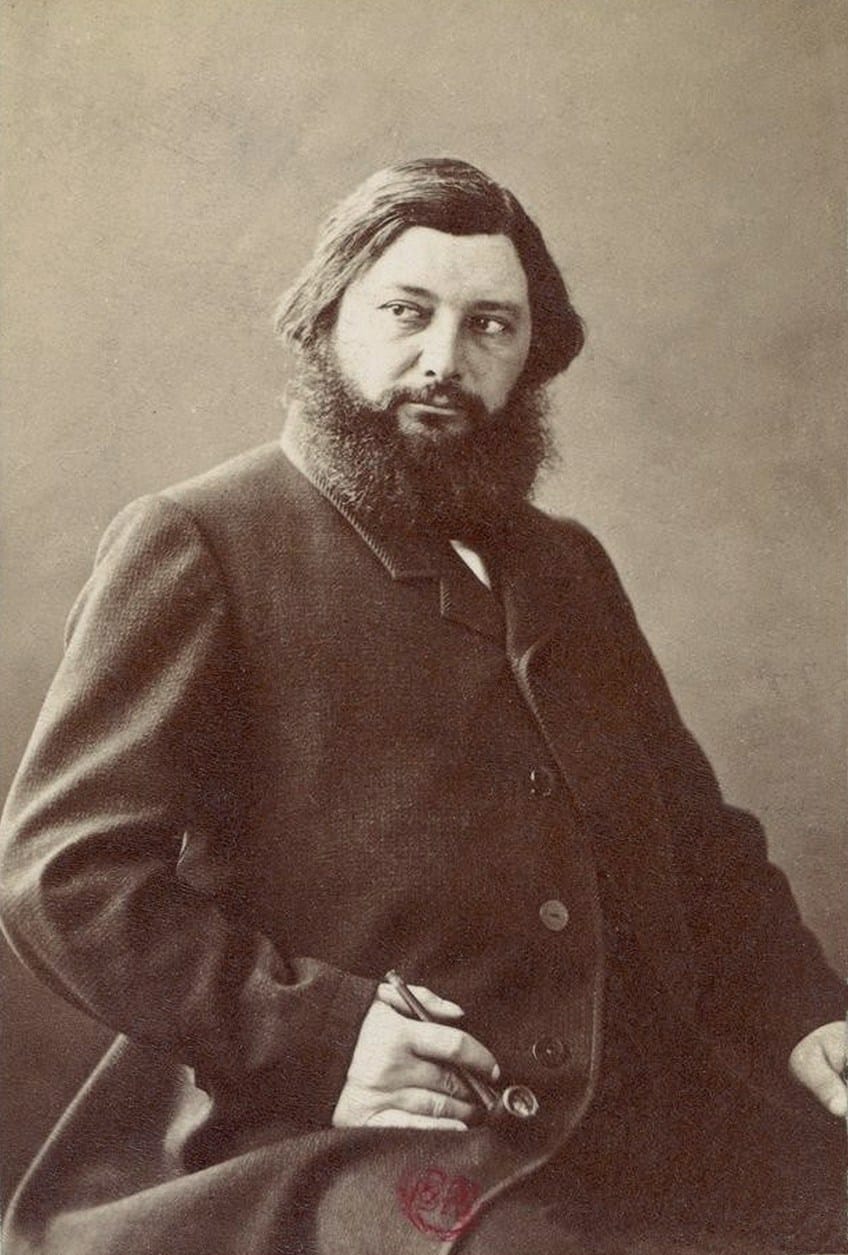
Formal Analysis: A Brief Compositional Overview
Below we will look at L’Origine du Monde in greater detail, the subject matter as well as the stylistic approaches in terms of art elements and principles color, brushwork, form, space, perspective, and so forth.
Visual Description: Subject Matter
L’Origine du Monde depicts a fair-skinned female nude lying down with her legs spread open, revealing her genitalia. The foreground is composed of the woman’s upper thighs, hips, and genitalia, with the middle ground and background composed of her torso. Her upper chest, neck, head, and face are not visible and appear to be covered with a white sheet or blanket. This also partially covers her breasts, of which her right (our left) breast is visible.
The rest of her body, from her torso downwards, is naked, and the composition is cut off by her upper thighs, leaving her legs and feet out of the frame.
Courbet depicted the scene as a close-up from between the woman’s legs. The nude’s body fills up most of the composition and there is not much indication of where she is lying. To the upper left of the composition, the background appears dark, which could be part of a bed she is lying on, or possibly the room around her. Part of the bed is also visible underneath the white sheet/blanket on the lower edge of the composition.
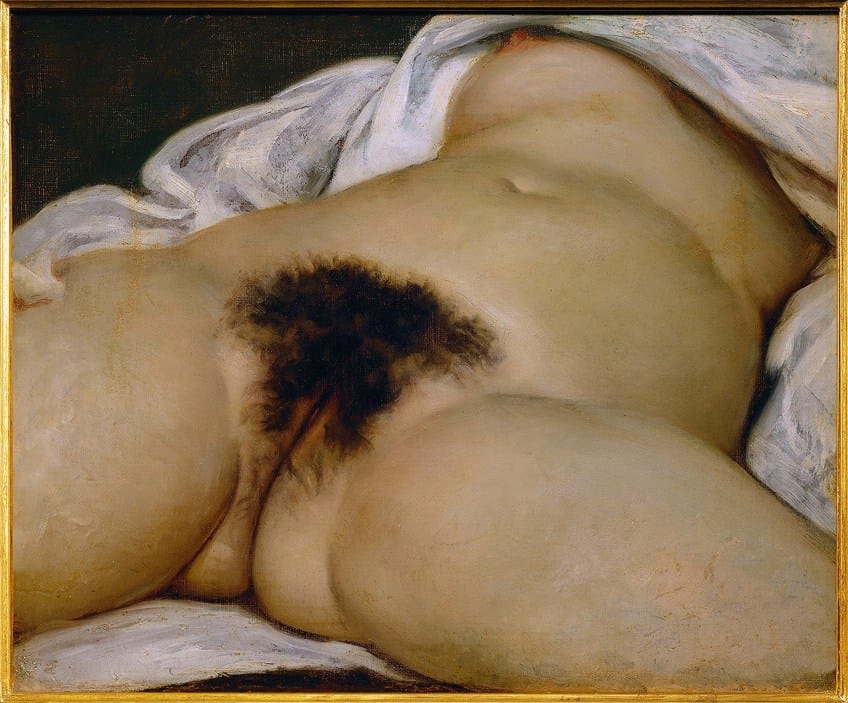
Color and Value
There is a notable contrast between light and dark in this composition. The dominant colors in L’Origine du Monde are mostly from the female nude’s body, her skin tone, which is fair in color, and the whites from the bed sheet/blanket. These are contrasted with the dark, almost black color of the background and the woman’s pubic hair, which appears dark brown or black.
We see other areas of color as well, like the pinks from the woman’s nipples and her genitalia, more specifically the vulva.
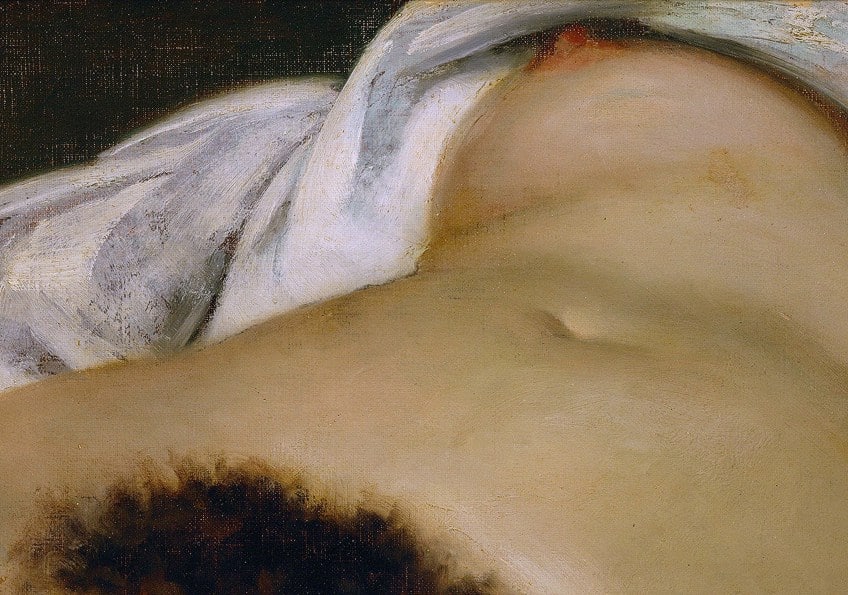
Texture
There is an implied texture on the female’s body; we can see this on her skin, which appears voluptuous, especially in the manner Courbet depicted the folds of the buttocks and upper thighs. We also see implied texture on the pubic hair, which appears curly and bushy. The white sheet/blanket also appears softer as it folds over and around the female’s body.
Although there is an indication of implied texture, giving character to the subject matter, we are also able to see the physical texture from Courbet’s paintbrush. The brushstrokes appear thicker and looser in the application, which was a characteristic of Courbet’s painting style.
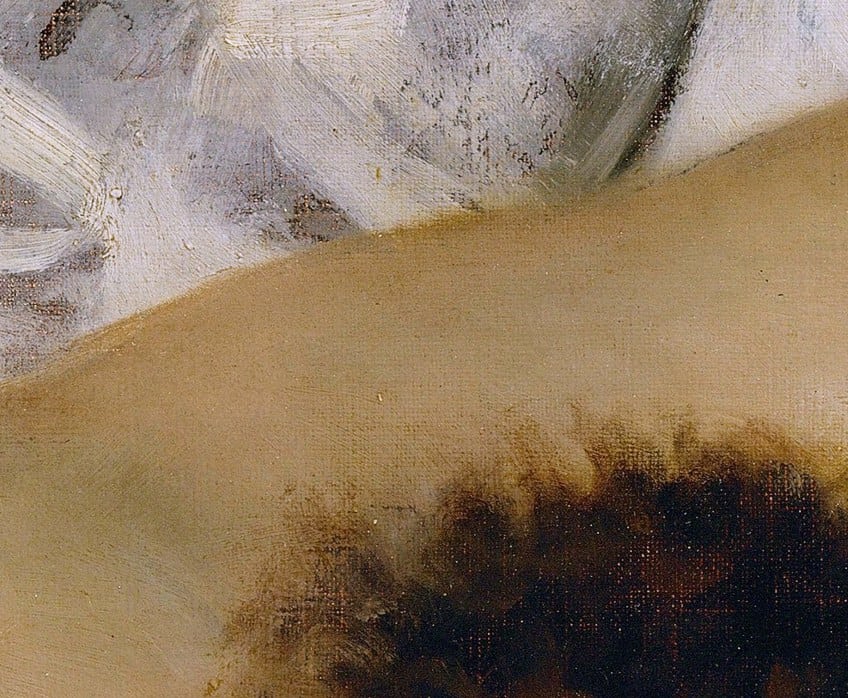
Line, Form, and Shape
There is a diagonal and vertical line formed from the positioning of the woman’s body, and her figure is slightly angled to the right of the composition, revealing the open space to the left. The woman’s figure also forms an inverted “Y” shape when we look at the overall composition. Furthermore, there are various other curved lines and rounded shapes, such as the various folds of the skin and bed sheet/blanket.
These give the composition a seeming fluidity and rhythm and add to the femininity and voluptuous quality of the woman, emphasizing her sexuality and the erotic nature of the composition.
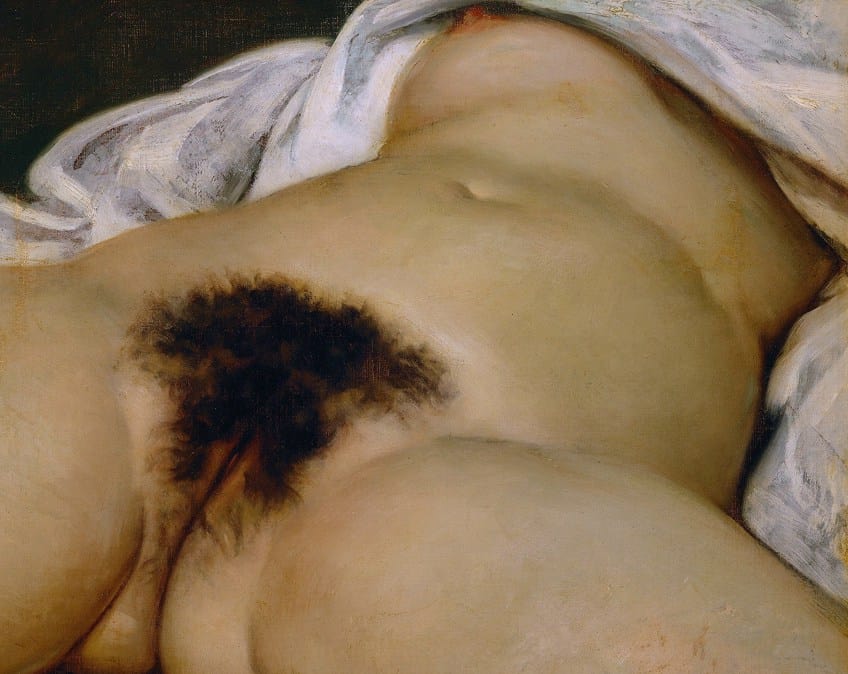
Space
The Origin of the World by Gustave Courbet is not a large painting, measuring 46.3 centimeters in height and 55.4 centimeters in length. There appears to be a foreshortened perspective utilized in this composition, the foreground emphasizing the female genitalia and thus the eroticism of the subject matter.
It is almost as if the woman’s legs reach into our (the viewers) space.
Furthermore, Courbet seemingly suggests a continuity of the female form by cropping her figure at the edges of the composition. Her genitalia exposed fills the compositional space, drawing our attention to it as the focal point.
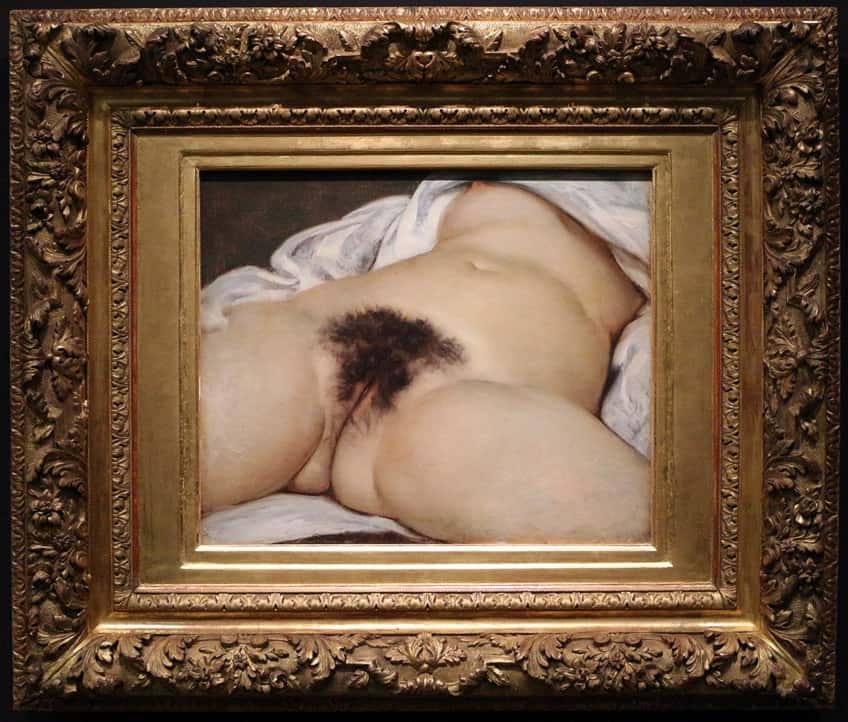
The Mystery of the Model
It is believed that the red-haired Joanna Hiffernan, otherwise referred to as “Heffernan”, was the model for Gustave Courbet in The Origin of the World painting. She reportedly also modeled in some of the artist’s other paintings including paintings for the American artist James Abbott McNeill Whistler.
There are various debates surrounding the identity of the model because Hiffernan had red hair, which is not anatomically accurate because the pubic hair of the model in Courbet’s painting is a dark brown/black color.
Some have suggested that it could have been Constance Queniaux, who was a ballet dancer, and Kahlil Bey’s mistress.
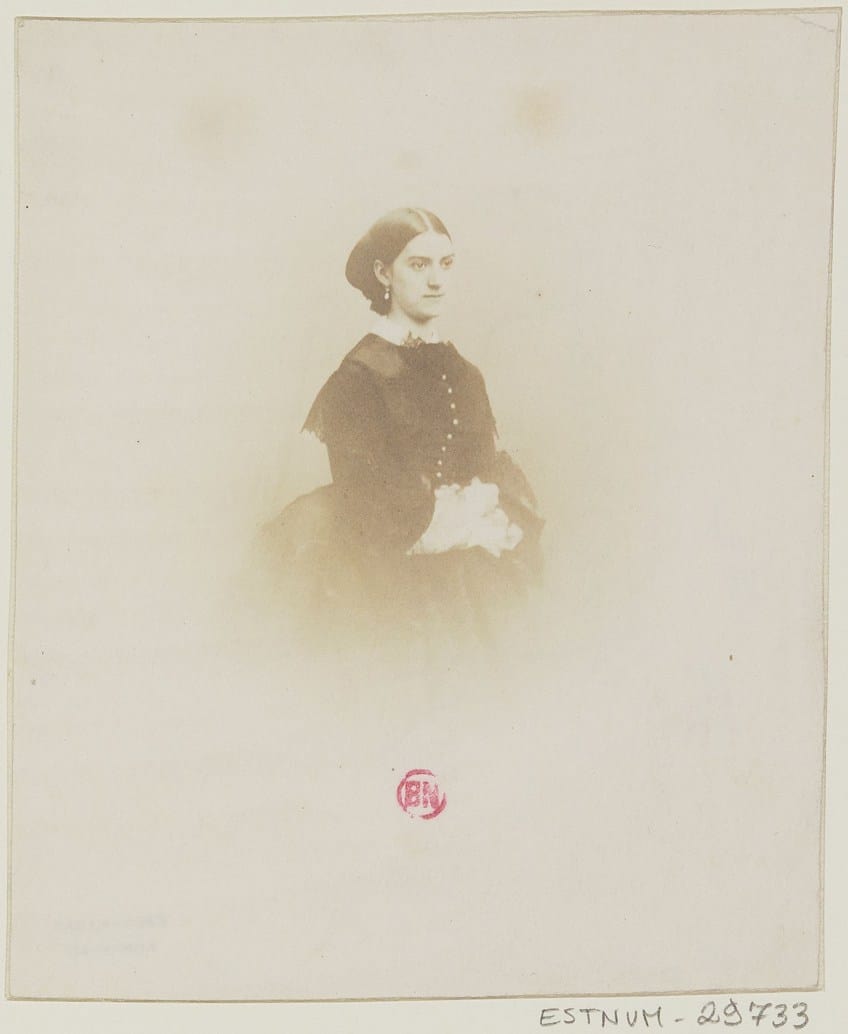
Kahlil Bey was an Ottoman diplomat – his full name was Halil Şerif Pasha. Many art sources also point to him as the commissioner of the painting. The identity of the model as Constance Queniaux is also often attributed to Claude Schopp, a writer, and scholar. In letters between Alexander Dumas and George Sand, it was reportedly written about how the “interior” parts of the ballet dancer were not to be painted, suggesting the intimacy of the painting.
This also points to the painting as being part of the Ottoman diplomat’s personal erotic collection.
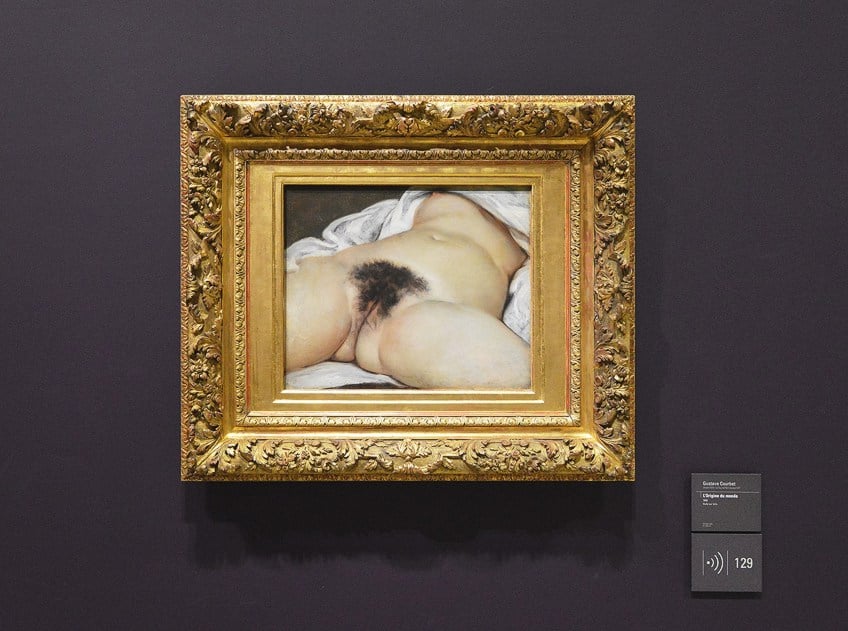
At the Origin of the World
The Origin of the World by Gustave Courbet has passed through many hands, from initially being in Khalil Bey’s collection it was also looted by the Soviet military troops and eventually sold to Jacques Lacan, who was a well-renowned psychoanalyst, in the 1900s. When he died, it was given to the Musée d’Orsay in Paris, where it currently resides.
“The Origin of the World” painting has similarly been repurposed by many hands in the pop-cultural age. It has become the topic for numerous gender and sexuality theories and studies, especially ideas around voyeurism. It has also become the victim of censorship throughout a variety of media, tentatively pushing the boundaries between art and pornography. In whatever way we choose to view Gustave Courbet’s “L’Origine du Monde” painting, we will be confronted with the truth, the realism that the artist so steadfastly stood for. At the origin of the world, we are made.
Frequently Asked Questions
Who Painted The Origin of the World?
The Origin of the World was painted in 1866 by the French artist Gustave Courbet. It is titled L’Origine du Monde in French and was reportedly commissioned by a diplomat named Kahlil Bey.
What Is The Origin of the World?
The Origin of the World (1866) is an oil painting by Gustave Courbet, who was a French artist known to spearhead the Realism art style. It is an erotic portrayal, depicting a nude female figure with her legs open, revealing her genitalia.
Who Is the Model in Gustave Courbet’s L’Origine du Monde?
Various questions have been raised about who the woman was in Gustave Courbet’s oil painting L’Origine du Monde (The Origin of the World) (1866). Some suggest it was the model Joanna Hiffernan or otherwise Constance Queniaux. Some sources also suggest other possible models.
Alicia du Plessis is a multidisciplinary writer. She completed her Bachelor of Arts degree, majoring in Art History and Classical Civilization, as well as two Honors, namely, in Art History and Education and Development, at the University of KwaZulu-Natal, South Africa. For her main Honors project in Art History, she explored perceptions of the San Bushmen’s identity and the concept of the “Other”. She has also looked at the use of photography in art and how it has been used to portray people’s lives.
Alicia’s other areas of interest in Art History include the process of writing about Art History and how to analyze paintings. Some of her favorite art movements include Impressionism and German Expressionism. She is yet to complete her Masters in Art History (she would like to do this abroad in Europe) having given it some time to first develop more professional experience with the interest to one day lecture it too.
Alicia has been working for artincontext.com since 2021 as an author and art history expert. She has specialized in painting analysis and is covering most of our painting analysis.
Learn more about Alicia du Plessis and the Art in Context Team.
Cite this Article
Alicia, du Plessis, ““The Origin of the World” by Gustave Courbet – Art by Gustave Courbet.” Art in Context. June 27, 2022. URL: https://artincontext.org/the-origin-of-the-world-by-gustave-courbet/
du Plessis, A. (2022, 27 June). “The Origin of the World” by Gustave Courbet – Art by Gustave Courbet. Art in Context. https://artincontext.org/the-origin-of-the-world-by-gustave-courbet/
du Plessis, Alicia. ““The Origin of the World” by Gustave Courbet – Art by Gustave Courbet.” Art in Context, June 27, 2022. https://artincontext.org/the-origin-of-the-world-by-gustave-courbet/.


